Table of Contents
Toggle
Solar energy is a renewable energy source that harnesses the power of the sun to generate electricity. Unlike fossil fuels, solar power is clean, abundant, and sustainable, making it a key player in the global shift towards greener energy solutions. The benefits of solar energy are far-reaching: it reduces greenhouse gas emissions, lowers energy bills, and provides energy independence by decreasing reliance on grid-based power. Additionally, solar technology has become more accessible and affordable, making it an increasingly viable option for homeowners, businesses, and governments alike.

Proper understanding and execution of solar installation are crucial to unlocking the full potential of solar energy. A well-planned and precisely executed installation ensures that solar panels operate at peak efficiency, capturing the maximum amount of sunlight and converting it into usable electricity.
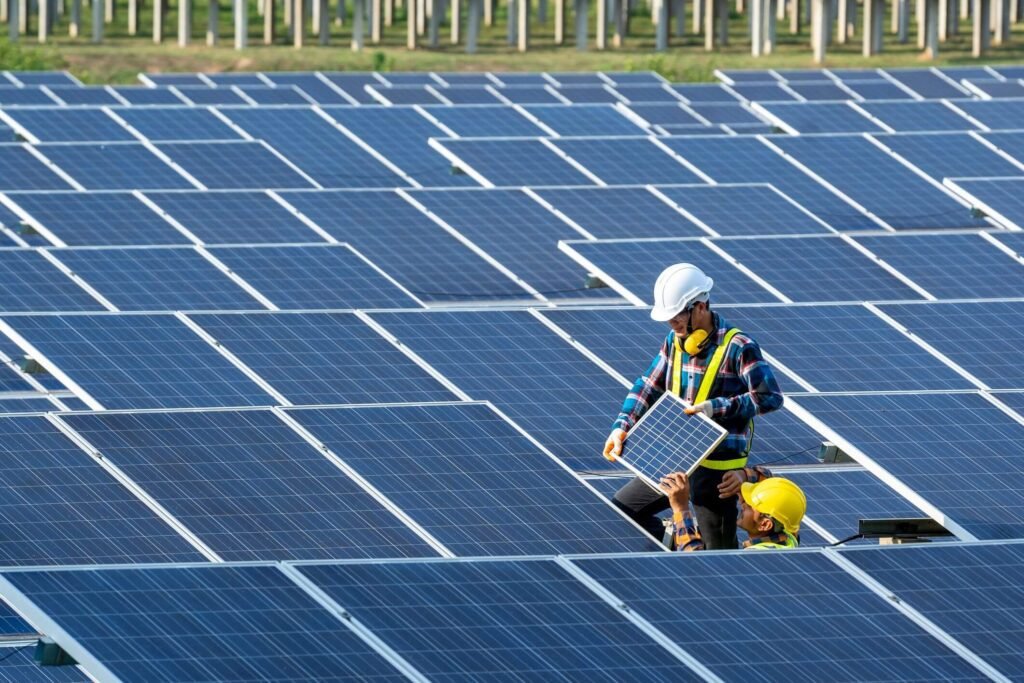

This not only enhances the system’s performance but also extends its lifespan, providing long-term savings and a higher return on investment. Moreover, understanding the intricacies of solar installation helps in avoiding common pitfalls, such as improper panel placement, shading issues, and inadequate system sizing, which can significantly impact the efficiency and overall effectiveness of the solar power system.
By mastering the principles of solar installation, individuals and businesses can contribute to a more sustainable future while reaping the full benefits of solar energy.
This guide is designed to equip readers with comprehensive knowledge about solar energy installations.
1. What is solar power?
Solar power is a renewable and clean energy source, meaning it doesn’t produce harmful emissions or deplete natural resources. It has gained popularity due to its environmental benefits and the decreasing cost of solar panel technology. Solar power systems can be installed on rooftops, in large solar farms, or even in smaller, portable setups, making it a versatile option for generating electricity in various settings.
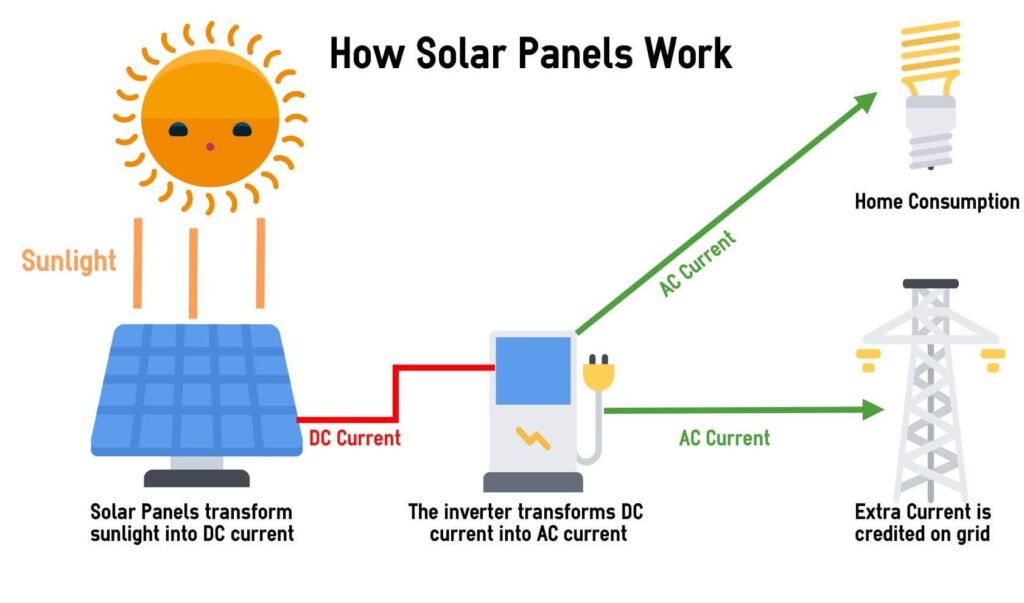

1.1 Working principle of a solar power system
Solar power is the energy generated by converting sunlight into electricity. This is typically done using solar panels, which consist of photovoltaic (PV) cells that capture sunlight and convert it into direct current (DC) electricity. This DC electricity is then converted into alternating current (AC) electricity, which can be used to power homes, businesses, and other applications.
1.2 Key Components
Solar power systems consist of several key components, each playing a crucial role in capturing, converting, and utilizing solar energy. Here are the main components in common solar power systems:
- Solar Panels (Photovoltaic Panels): These are made up of photovoltaic (PV) cells that convert sunlight directly into direct current (DC) electricity. The panels are typically mounted on rooftops or in solar farms.
- Inverter: This device converts the DC electricity generated by the solar panels into alternating current (AC) electricity, which is used by most household appliances and can be fed into the electrical grid.
- Batteries: For systems that store energy (often in off-grid or hybrid systems), batteries store excess electricity generated during sunny periods for use when sunlight is not available. This is especially useful for nighttime or cloudy conditions.
- Electrical wiring components: Include wires and cables that carry electrical current, conduits for routing and protecting these wires, and connectors and terminals for joining them. Junction and outlet boxes house wiring connections and devices, while switches and circuit breakers control and protect electrical circuits.
2. Different Types of Solar Panels


Solar panels are essential for converting sunlight into electricity, and understanding the different types available can help you choose the best option for your needs. In this guide, we’ll explore the three main types of solar panels: Monocrystalline, Polycrystalline, and Thin-Film. Each type has its own unique characteristics, benefits, and drawbacks.
2.1 Monocrystalline Solar Panels
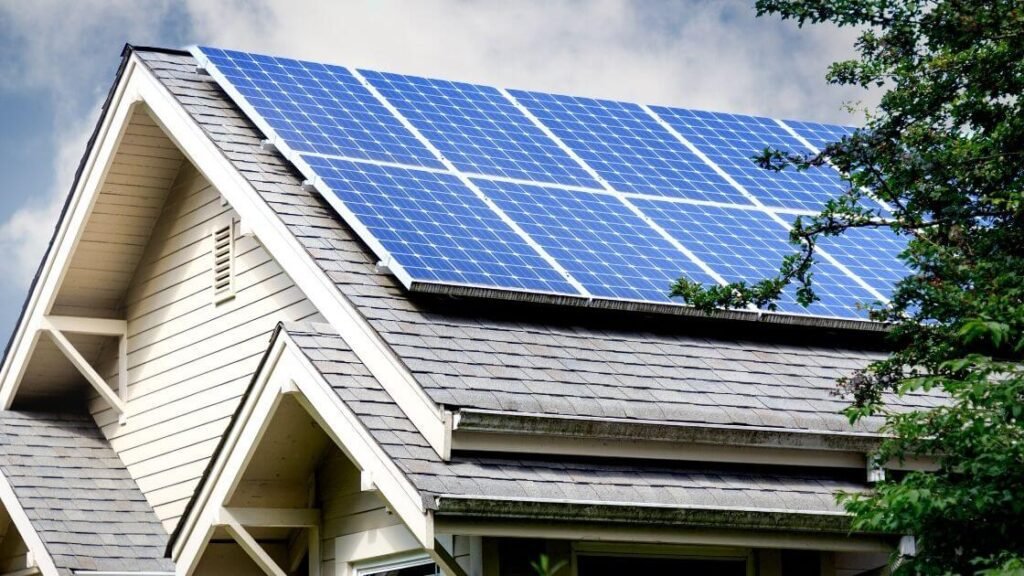

- Monocrystalline solar panels are crafted from a single, pure silicon crystal, which gives them their distinctive black color. They are known for their high efficiency and sleek design, making them a popular choice for residential and commercial installations where space is limited.
- Advantages: Monocrystalline panels are the most efficient type of solar panel, typically converting 15-20% of sunlight into electricity. Their high efficiency means they require less space compared to other types, making them ideal for installations with limited roof space. Additionally, their uniform black appearance is aesthetically pleasing and complements modern architectural styles. Monocrystalline panels also perform well in low-light conditions, ensuring consistent energy production even on cloudy days.
- Disadvantages: The main drawback of monocrystalline panels is their cost. They are more expensive than polycrystalline and thin-film panels due to the complex manufacturing process involved in creating a single crystal structure. Although they are highly efficient, their performance can slightly decrease in extremely high temperatures, which may be a consideration in particularly hot climates.
2.2 Polycrystalline Solar Panels


- Polycrystalline solar panels are made from multiple silicon crystals melted together, giving them a distinctive blue, speckled appearance. These panels offer a more affordable alternative to monocrystalline panels, though they come with some trade-offs in terms of efficiency and aesthetics.
- Advantages: Polycrystalline panels are generally more affordable than their monocrystalline counterparts, making them a cost-effective option for many installations. The manufacturing process is simpler and less energy-intensive, contributing to the lower price. Polycrystalline panels are a good choice for those who have ample roof space and are looking for a budget-friendly solution that still offers reliable energy production.
- Disadvantages: One of the main disadvantages of polycrystalline panels is their lower efficiency, typically ranging from 13-16%. This means that more panels are needed to produce the same amount of electricity as monocrystalline panels, which can be a disadvantage in space-constrained installations. Additionally, their blue, speckled appearance is often considered less attractive, which may be a factor for those concerned with the visual impact of their solar installation.
2.3 Thin-Film Solar Panels
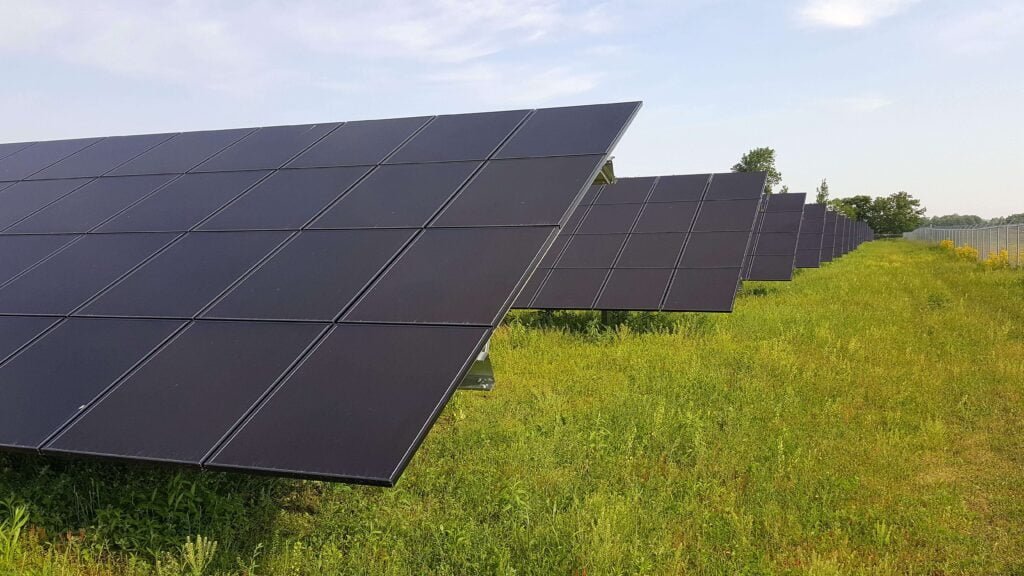

- Thin-film solar panels are created by depositing photovoltaic material onto a substrate, resulting in lightweight, flexible panels. These panels are less efficient than crystalline panels but offer unique advantages in certain applications, particularly where flexibility and weight are important considerations.
- Advantages: Thin-film panels are highly versatile, as they can be manufactured on flexible substrates, allowing them to be used on curved surfaces or integrated into building materials. Their lightweight nature makes them easier to handle and install, and they are less affected by high temperatures compared to crystalline panels. Thin-film panels also tend to have a more uniform appearance, which can be aesthetically appealing for certain installations.
- Disadvantages: The primary disadvantage of thin-film panels is their lower efficiency, usually around 10-12%. This means that significantly more space is required to generate the same amount of power as monocrystalline or polycrystalline panels. As a result, thin-film panels are generally not ideal for residential installations with limited space. Additionally, they may have a shorter lifespan and degrade more quickly over time, leading to potentially higher maintenance costs.
3. The 3 Different Types of Solar Inverters
Inverters are critical components in rooftop solar systems, responsible for converting the direct current (DC) generated by solar panels into alternating current (AC) that can be used by household appliances. The performance and efficiency of your solar system heavily depend on the type of inverter you choose. The three primary types of inverters available for rooftop systems are string inverters, microinverters, and power optimizers. Each type has its unique advantages and disadvantages, making it essential to understand their differences to select the best option for your specific needs.


3.1 String Inverters
- String inverters are the most common and cost-effective choice for residential solar installations. In this setup, multiple solar panels are connected in a series to form a “string,” which is then connected to a single inverter that converts the DC from the entire string into AC.
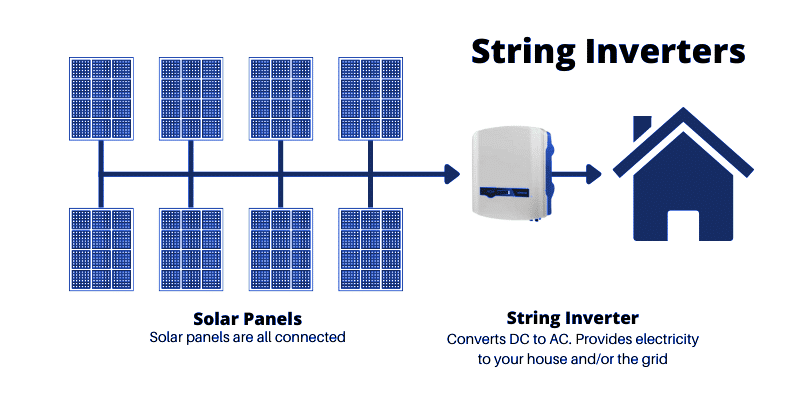

- Advantages: String inverters are known for their simplicity and affordability. Since the system uses a single inverter, installation and maintenance are straightforward, making them a popular choice for homeowners. Additionally, they offer a proven technology with a long track record of reliability.
- Disadvantages: The main drawback of string inverters is that the performance of the entire system can be impacted if one panel in the string is shaded or malfunctioning. Since monitoring is done at the string level, it can be challenging to identify and address issues with individual panels, potentially leading to reduced overall efficiency.
3.2 Microinverters
- Microinverters are installed on each individual solar panel, allowing each panel to operate independently. This means that the DC to AC conversion happens at the panel level, making microinverters an ideal choice for systems where panels might be subject to shading or have different orientations.


- Advantages: The primary advantage of microinverters is their ability to maximize energy output from each panel, ensuring that shading or issues with one panel do not affect the entire system. This setup also allows for detailed monitoring at the panel level, providing precise data on the performance of each panel.
- Disadvantages: While microinverters offer enhanced performance and monitoring capabilities, they are generally more expensive upfront compared to string inverters. The installation process is also more complex, as each panel requires its own inverter, which can increase labor costs and complicate maintenance.
3.3 Power Optimizers
- Power optimizers combine some benefits of both string inverters and microinverters. They are installed on each solar panel, optimizing the DC output before sending it to a central string inverter for conversion to AC. This setup allows each panel to operate at its optimal efficiency while still using a centralized inverter.
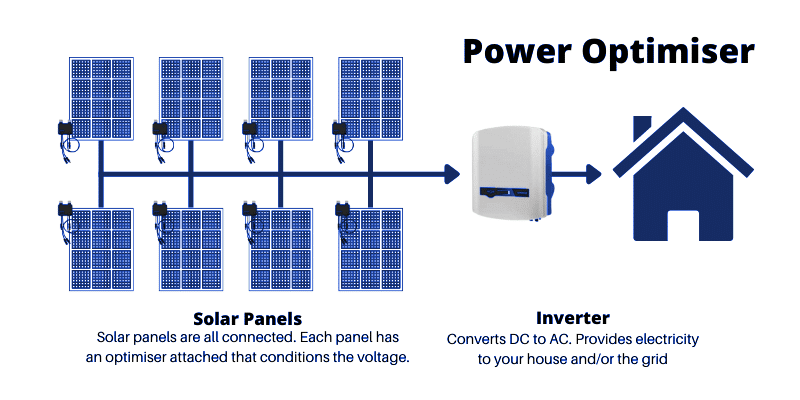

- Advantages: Power optimizers improve system performance by reducing the impact of shading and mismatched panels, similar to microinverters. They also offer panel-level monitoring, enabling more detailed diagnostics. However, power optimizers are often less expensive than microinverters, making them a cost-effective alternative.
- Disadvantages: Despite their benefits, power optimizers still require a central string inverter, which means they do not entirely eliminate the need for a single point of failure. This can be a disadvantage compared to microinverters, where each panel operates independently. Additionally, the system can be more complex to install and maintain compared to traditional string inverters due to the added components on each panel.
4. The 3 Different Types of Solar Power Systems
4.1 Grid-Tied Solar Power Systems
Grid-tied solar power systems are the most common type of solar energy setup, directly connected to the public electricity grid. These systems allow homeowners and businesses to generate their own electricity while remaining connected to the grid for additional power when needed. During the day, solar panels produce electricity, which can be used immediately or sent back to the grid if there’s excess production. This system is highly efficient because it maximizes the use of solar energy while ensuring that there’s always a backup power source.


One of the key advantages of grid-tied systems is cost-effectiveness. Since they don’t require expensive battery storage, the initial investment is lower compared to other types of systems. Additionally, many utility companies offer net metering, allowing users to sell excess electricity back to the grid, potentially reducing their electricity bills. This makes grid-tied systems ideal for residential and commercial use in areas where the grid is easily accessible.
However, grid-tied systems are dependent on the electricity grid, which means they won’t provide power during outages unless paired with additional battery storage. This dependency on the grid can be a limitation for those looking for complete energy independence. Despite this, grid-tied systems remain a popular choice for those looking to reduce energy costs while contributing to a greener future.
4.2 Off-Grid Solar Power Systems
Off-grid solar power systems operate independently from the public electricity grid, making them a perfect solution for remote areas or locations without reliable grid access. These systems are fully self-sufficient, using solar panels to generate electricity, which is then stored in batteries for use when sunlight is unavailable. This setup ensures a continuous power supply, even in areas far from urban centers, making it popular in rural settings, remote cabins, and boats.


The main advantage of off-grid systems is their ability to provide complete energy independence. Without reliance on the grid, users can generate and consume their own power, which is particularly valuable in areas where grid power is unreliable or unavailable. Additionally, off-grid systems promote sustainability by using 100% renewable energy, reducing the need for fossil fuels and decreasing carbon footprints.
However, off-grid systems come with higher initial costs due to the need for batteries and other storage solutions. Maintaining these batteries can also be challenging, as they require regular upkeep and eventual replacement. Furthermore, the energy supply is limited by battery capacity and weather conditions, meaning that energy availability can fluctuate, especially during prolonged periods of cloudy weather. Despite these challenges, off-grid systems are a viable solution for those seeking autonomy from traditional power sources.
4.3 Hybrid Solar Power Systems
Hybrid solar power systems combine the features of both grid-tied and off-grid systems, offering the best of both worlds. These systems are connected to the electricity grid while also incorporating battery storage, allowing users to store excess solar energy for later use or during grid outages. This dual capability makes hybrid systems particularly attractive for those who want the security of backup power while still being able to sell surplus electricity back to the grid.


The flexibility of hybrid systems is one of their greatest advantages. They can optimize energy use by storing excess solar energy during the day and using it at night or during outages, ensuring a continuous power supply. This makes hybrid systems suitable for areas prone to power interruptions, as they provide energy security and resilience. Additionally, the ability to store and manage energy more effectively can lead to further cost savings over time.
However, the inclusion of battery storage makes hybrid systems more expensive than standard grid-tied systems. The installation process is also more complex, requiring careful management and integration of various components. Moreover, batteries need ongoing maintenance and will eventually need replacement, adding to the overall cost. Despite these factors, hybrid systems are an excellent choice for those looking for a balanced approach to energy independence and reliability.
5. Preparation before Solar Power System installation
5.1 Obtain Necessary Permits
Before starting your electrical conduit installation project, it’s crucial to handle legal and administrative tasks to ensure smooth progress and compliance.


The first step is to acquire the required permits. Start by contacting your local building and electrical departments to find out which permits are necessary for your project. The specific requirements can vary by location, so getting accurate information is key.
Next, check with your Homeowners Association (HOA) to see if there are any restrictions or guidelines that apply to your project. Complying with these rules helps prevent potential conflicts and fines.
Also, confirm that your project meets utility company requirements, especially if it involves electrical connections. Ensuring compliance with these regulations helps avoid issues with service and ensures a safe installation.
5.2 Assessing Solar Needs
5.2.1 For Residential Systems
Determining Energy Requirements


Before you invest in a solar system, understanding your energy needs is essential. Start by reviewing your electricity bills to determine your average monthly usage in kilowatt-hours (kWh). This figure will guide you in selecting a solar system that can meet your needs. Consider any changes in your energy consumption, such as the addition of new appliances or an electric vehicle, as these will impact your requirements.
Calculating System Size
Once you know your energy needs, calculate the size of the solar system required. The size is typically measured in kilowatts (kW). To estimate the system size, divide your monthly energy usage by the average number of sunlight hours your location receives per day. For instance, if you use 900 kWh per month and your area gets 5 sunlight hours per day, you would need a system that generates around 6 kW to cover your usage.
5.2.2 For Power Plants
Understanding Energy Demand
For a power plant, accurately determining energy demand involves analyzing historical data and future projections for energy consumption. This includes:
- Load Analysis: Evaluate the total energy load, peak demand periods, and load profiles to understand the maximum and minimum energy needs throughout the day and year.
- Future Growth: Account for expected increases in energy demand due to expansion or new projects to ensure that the solar system can meet long-term needs.


Calculating System Size
The scale of a power plant’s solar system is significantly larger than that of residential installations. Key considerations include:
- Energy Output Requirements: Calculate the total kilowatt-hour (kWh) or megawatt-hour (MWh) output required from the solar system to meet the plant’s energy needs.
- Land and Space Availability: Assess the available space for solar panel installation, as power plants often require extensive land areas.
- System Efficiency and Redundancy: Design the system for high efficiency and incorporate redundancy to maintain power supply during maintenance or unexpected conditions.
5.3 Choosing Solar Panels
There are three main types of solar panels: monocrystalline, polycrystalline, and thin-film. We’ve already discussed this before.
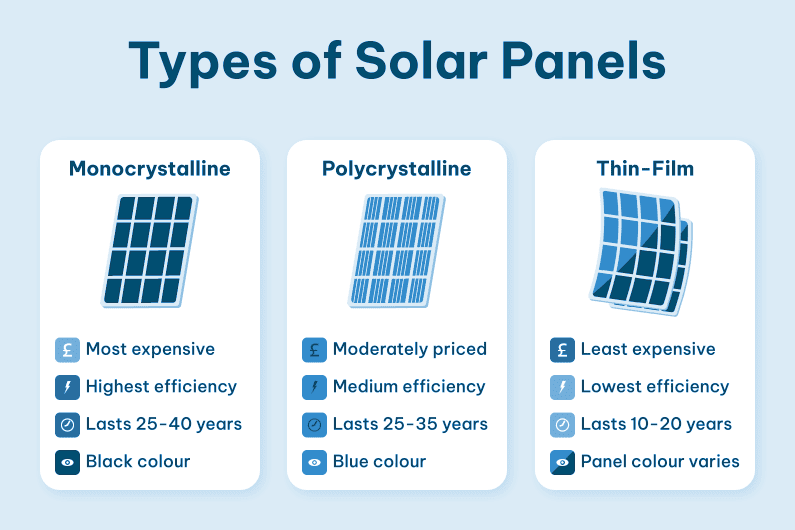

- For residential installations, choose panels based on your roof type and orientation. Monocrystalline panels are often preferred for their high efficiency and compact size, suitable for roofs with limited space. Ensure your roof can support the weight of the panels and consider potential shading from trees or structures.
- For larger-scale power plants, focus on panels that balance efficiency with cost-effectiveness. Polycrystalline panels might be suitable where space is ample and cost savings are a priority. Evaluate panel performance in varying environmental conditions and ensure compatibility with the overall design of the power plant.
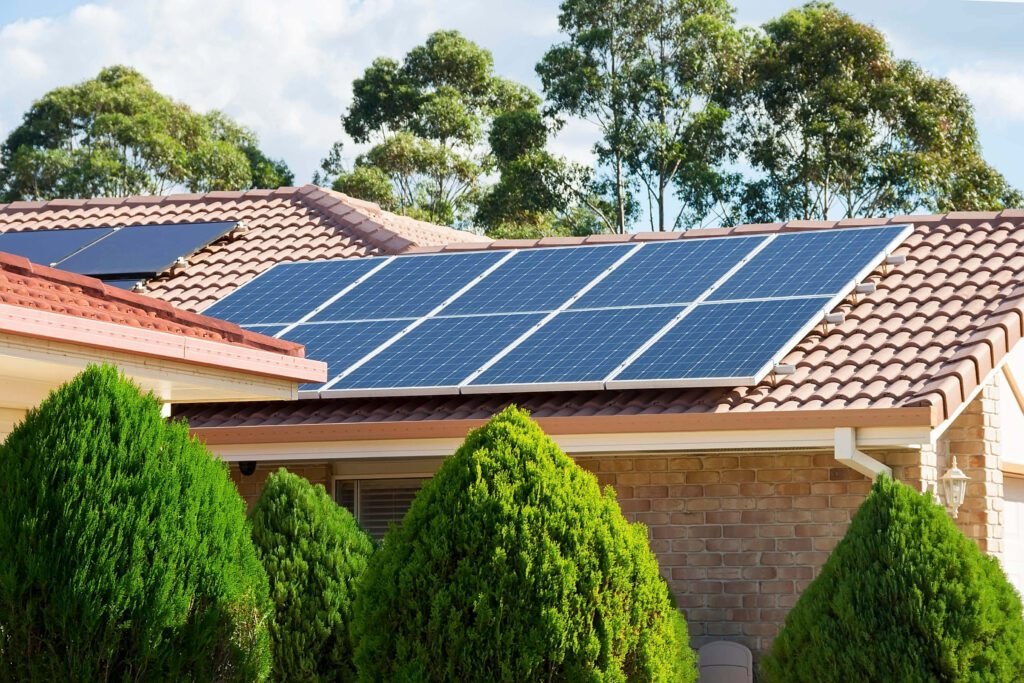

To ensure the best choice for your solar energy system, consult with the supplier or a professional expert in solar panel selection and installation. They can offer tailored advice based on your specific needs, roof characteristics, and energy requirements. Professional guidance will help you make an informed decision, ensuring proper installation and addressing any site-specific challenges.
5.4 Choosing Inverters
There are three main types of inverters. We’ve already discussed this before.
When choosing an inverter for solar systems, the type of installation—residential or power plant—plays a significant role.
For residential solar setups, microinverters or power optimizers are often the best choices. Microinverters allow each panel to operate independently, making them ideal for homes with shading issues or complex roof layouts.
They offer detailed performance monitoring and easy scalability. Power optimizers, while also optimizing panel performance, work with a central inverter and provide similar benefits in handling shading and varying panel orientations.


On the other hand, string inverters are typically more suitable for large-scale power plants. They are cost-effective and efficient for systems with a more predictable and uniform panel layout. String inverters simplify the installation process and are well-established for their reliability in extensive installations.
However, they may face performance challenges if individual panels experience shading or issues, as the entire system’s output can be affected.
5.5 Determine Mounting System Type
When determining the best mounting system for a personal house or power plant, it’s essential to consider various factors to ensure optimal performance and efficiency.


For a personal house, roof-mount systems are often the most suitable choice, utilizing existing roof space without occupying valuable ground area. This type is advantageous for its minimal visual impact and straightforward integration with the home’s structure. However, it’s important to ensure that the roof can support the additional weight and is accessible for maintenance.


In contrast, ground-mount systems are generally preferred for power plants, particularly large-scale installations. These systems provide greater flexibility in positioning, allowing for optimal orientation and angle adjustments to maximize energy production. They also make maintenance and cleaning easier compared to roof-mounted systems. While they do use ground space, which may be a consideration for residential projects, their scalability and ease of access make them ideal for power plants where large areas are available.


Pole-mount systems offer a middle ground by elevating the panels, which can help avoid shading from nearby obstacles and makes efficient use of ground space underneath. This type of mounting system can be advantageous for both personal houses and power plants, especially in areas where space is constrained or where shading is a concern. However, it requires a stable foundation and may be exposed to more extreme weather conditions.
5.6 Conduit Selection
When installing solar panels, selecting the appropriate conduit is crucial to ensure the system’s efficiency and longevity. Conduits protect and route the electrical wiring from the solar panels to the inverter and other components, safeguarding the cables from physical damage, environmental factors, and electrical hazards.


Proper conduit selection not only enhances the safety of the installation but also helps in maintaining compliance with local electrical codes and standards.
There are several types of conduits to consider, each with its own advantages and ideal applications. PVC conduits are lightweight, cost-effective, and resistant to corrosion, making them a popular choice for outdoor and underground installations. They are particularly beneficial in environments where UV protection is necessary to prevent degradation from sunlight.
On the other hand, metallic conduits offer superior protection against physical damage and provide grounding capabilities, making them suitable for areas with higher exposure to mechanical stress.
Understanding the advantages of each conduit type can help you select the most suitable option based on the specific requirements of your installation.


Ctube’s solar series conduits are crafted to withstand the rigors of outdoor environments, including exposure to UV rays and extreme temperatures. Made from durable PVC, these conduits are both lightweight and resistant to corrosion, making them ideal for routing and protecting electrical wiring in solar panel systems.
5.7 Evaluate Installation Condition and Orientation
When evaluating a roof for solar panel installation, it’s essential to consider the roof’s condition, orientation, and potential shading, with adjustments based on your geographical location.


- Roof Condition and Orientation: First, inspect the roof’s age and material. Older or damaged roofs may need repairs or replacement before installation. Ensure the roof can support the weight of the solar panels and mounting equipment. The ideal pitch for solar panels is typically between 30 and 45 degrees, but many systems are adaptable to various angles.
- Geographical Considerations: The direction your roof faces is crucial for maximizing solar energy production. In the Northern Hemisphere, south-facing roofs are optimal because they receive the most direct sunlight throughout the day. Conversely, in the Southern Hemisphere, north-facing roofs are preferred for the same reason. This directional alignment ensures that solar panels capture the maximum amount of sunlight, enhancing energy output.


- Shading Analysis: Assess potential shading from nearby trees, buildings, or other structures, as shading can significantly impact the efficiency of solar panels. Evaluate how shading might change with the seasons, as objects that cast minimal shadows in summer could create more significant shading in winter. Using tools like solar pathfinders or shading analysis software can help you accurately assess shading throughout the day and year.
6. How to Install Solar Panels : A Step-by-Step Guide
6.1 Gather Tools and components


- Drill: For creating holes in the roof to secure mounting brackets.
- Wrenches: To tighten bolts and nuts.
- Tape Measure: To ensure accurate measurements and proper alignment.
- Level: To make sure everything is installed correctly and evenly.
6.2 Mounting Brackets
Securing the mounting brackets is a foundational step in the installation process.
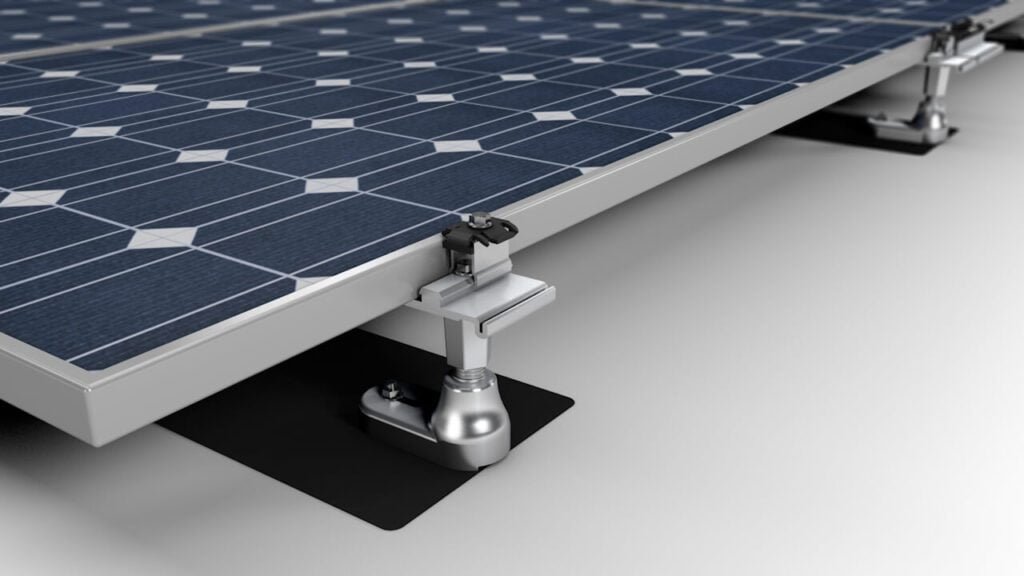

- Measure and Mark Locations: Carefully measure and mark where the brackets will be installed. For residential systems, this might be your roof, while for power plants, it could be ground-mounted systems or specialized structures.
- Drill Holes and Secure Brackets: Drill the necessary holes and secure the brackets with anchors. Ensure the brackets are firmly attached and properly aligned to support the panels.
6.3 Mount Solar Panels
With the brackets in place, you can now mount the solar panels.
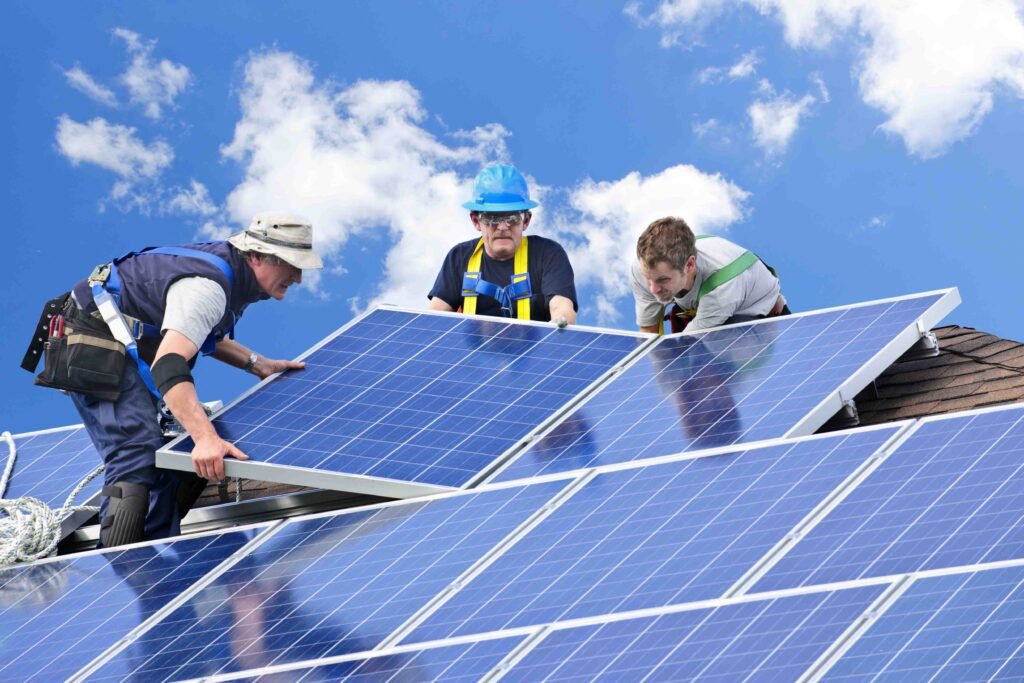

- Position Panels on Brackets and Secure: Place the panels onto the brackets and secure them according to the manufacturer’s instructions. For power plants, this may involve larger panels and more complex mounting systems.
- Ensure Proper Alignment and Tilt: Verify that the panels are aligned correctly and tilted to capture optimal sunlight. The angle and orientation will differ based on the installation type and location.
6.4 Install the Inverter
The inverter is vital for converting solar energy into usable electricity.


- Mount Inverter in a Suitable Location: Typically mounted on an exterior wall for residential systems, or in a dedicated area for power plants. Ensure it is in a location that allows for easy access and maintenance.
- Connect Inverter to Solar Panels: Follow the manufacturer’s guidelines to connect the inverter to the solar panels, ensuring proper and efficient operation.
6.5 Complete Electrical Wiring
Proper electrical wiring is essential for system functionality and safety.


- Connect Solar Panels to the Inverter: Use the correct wiring to connect the panels to the inverter.
- Wire Inverter to the Electrical Grid: Connect the inverter to the electrical grid and main service panel. This step ensures that the electricity generated can be used or fed back into the grid.
7. Testing and Commissioning
After the installation of a solar power system, thorough testing and commissioning are essential to ensure optimal performance and reliability.
The first step involves performing detailed system checks. This includes verifying all electrical connections and mounting hardware to confirm they are installed correctly and securely.
A meticulous inspection is crucial to prevent any potential issues that could affect system performance. Following this, the system is powered on, and its operation is observed. For large-scale power plants, this phase may involve comprehensive testing to evaluate the system’s performance under various conditions and ensure it meets reliability standards.
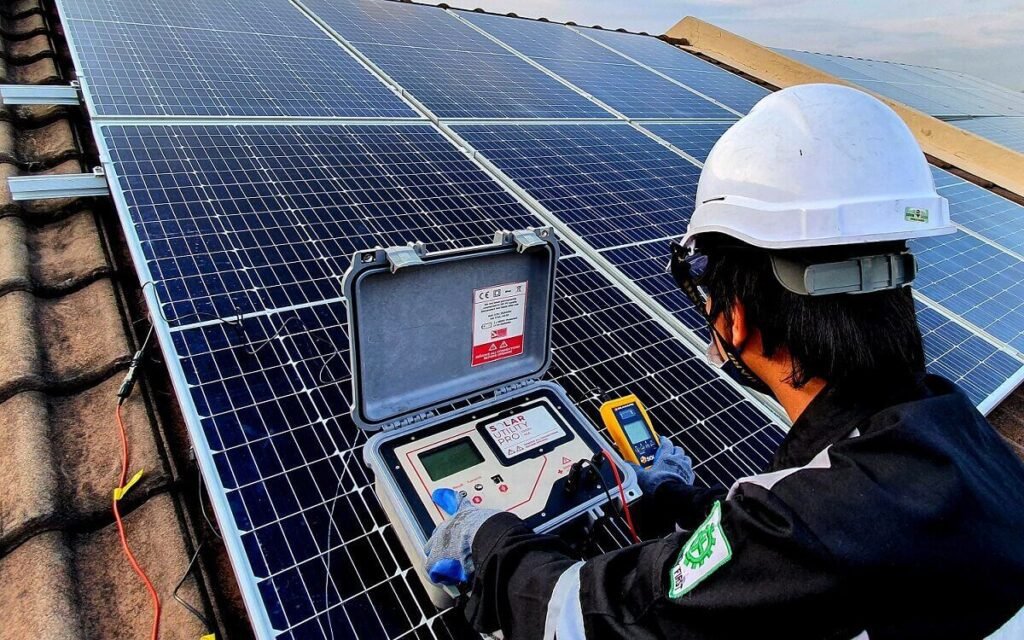

Once system checks are complete, setting up monitoring equipment is the next critical step.
Installing and configuring monitoring devices allows for continuous tracking of the system’s performance. These devices provide valuable data on energy production and system health, which is essential for maintaining efficiency.
Regularly reviewing this data helps verify that the system is performing as expected. Effective monitoring is key to optimizing energy output and ensuring that both residential and large-scale solar power plants operate efficiently over time.


FAQs
1. Flexible conduit and rigid conduit, which kinds of electrical conduit can be used in solar power installation?
Both can be used in solar panel installation. Flexible conduits are highly valued for their adaptability, making them ideal for routing around obstacles and connecting equipment in tight spaces.
Rigid conduits, on the other hand, provide superior protection and are preferred for longer runs where durability is essential. Their rigid structure offers enhanced mechanical protection and is ideal for environments where maximum protection from physical damage is required.
2. What factors should be considered when selecting a site for a power plant?
Site selection for a power plant involves evaluating several critical factors to ensure optimal performance and efficiency.
Key considerations include geographical location to maximize sunlight exposure—typically requiring a south-facing orientation in the Northern Hemisphere and north-facing in the Southern Hemisphere—along with assessing the site’s climate, access to infrastructure, and proximity to the power grid.
The site should also be free from significant shading by trees or buildings and have a stable, strong foundation capable of supporting the weight of the panels and associated equipment.
Additionally, local regulations and environmental impact assessments must be considered to ensure compliance and sustainability.
3. What maintenance is required after installing a solar power system?
Regular maintenance of a solar power system is crucial to ensure optimal performance and longevity.
This includes cleaning the solar panels to remove dust, dirt, and debris that can reduce efficiency, usually done every six months or as needed depending on your local environment. It’s also important to inspect the system periodically for any signs of damage, corrosion, or loose connections.
Additionally, check the inverter’s performance regularly, as it is a critical component of the system. Monitoring software can help track the system’s output and alert you to any issues. Lastly, battery maintenance (if applicable) should be performed according to the manufacturer’s guidelines to ensure long-term reliability and performance.








